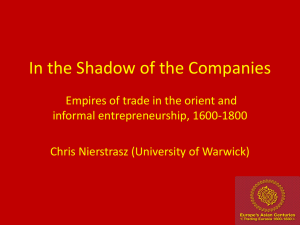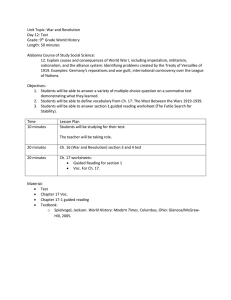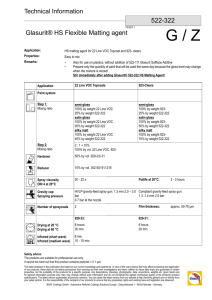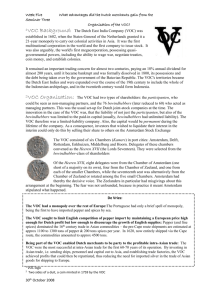In the Shadow of the Companies: Empires of Trade in... Entrepreneurship
advertisement
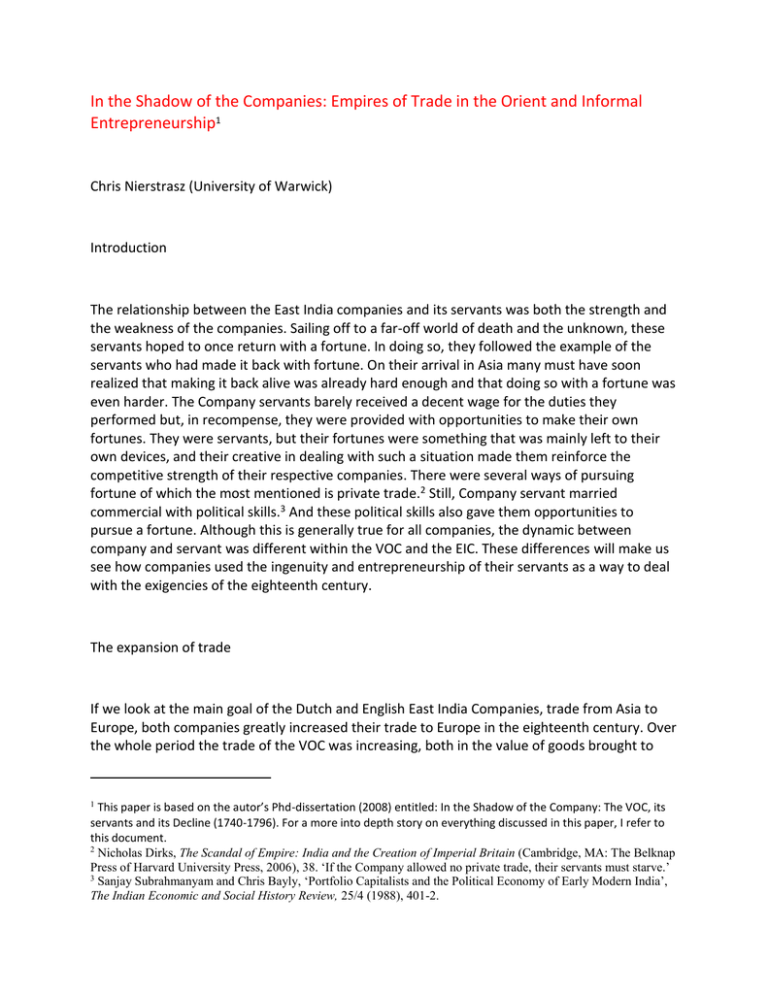
In the Shadow of the Companies: Empires of Trade in the Orient and Informal Entrepreneurship1 Chris Nierstrasz (University of Warwick) Introduction The relationship between the East India companies and its servants was both the strength and the weakness of the companies. Sailing off to a far-off world of death and the unknown, these servants hoped to once return with a fortune. In doing so, they followed the example of the servants who had made it back with fortune. On their arrival in Asia many must have soon realized that making it back alive was already hard enough and that doing so with a fortune was even harder. The Company servants barely received a decent wage for the duties they performed but, in recompense, they were provided with opportunities to make their own fortunes. They were servants, but their fortunes were something that was mainly left to their own devices, and their creative in dealing with such a situation made them reinforce the competitive strength of their respective companies. There were several ways of pursuing fortune of which the most mentioned is private trade.2 Still, Company servant married commercial with political skills.3 And these political skills also gave them opportunities to pursue a fortune. Although this is generally true for all companies, the dynamic between company and servant was different within the VOC and the EIC. These differences will make us see how companies used the ingenuity and entrepreneurship of their servants as a way to deal with the exigencies of the eighteenth century. The expansion of trade If we look at the main goal of the Dutch and English East India Companies, trade from Asia to Europe, both companies greatly increased their trade to Europe in the eighteenth century. Over the whole period the trade of the VOC was increasing, both in the value of goods brought to 1 This paper is based on the autor’s Phd-dissertation (2008) entitled: In the Shadow of the Company: The VOC, its servants and its Decline (1740-1796). For a more into depth story on everything discussed in this paper, I refer to this document. 2 Nicholas Dirks, The Scandal of Empire: India and the Creation of Imperial Britain (Cambridge, MA: The Belknap Press of Harvard University Press, 2006), 38. ‘If the Company allowed no private trade, their servants must starve.’ 3 Sanjay Subrahmanyam and Chris Bayly, ‘Portfolio Capitalists and the Political Economy of Early Modern India’, The Indian Economic and Social History Review, 25/4 (1988), 401-2. Europe as in their value of sales. The total purchase price of the Asian goods rose from 250 million in the seventeenth century to 600 million in the eighteenth century.4 The growth of the English East India Company was even more extreme, partly as a result of poor results up to 1700, its trade grew tenfold in the eighteenth century. 5 The miraculous growth of trade in both cases was not achieved by a growth of the consumption of spices, but was occasioned by the rise in consumption of new goods such as textiles, silks. coffee and tea. The English and new upcoming smaller companies took the lead in these news trades, while the VOC followed them close behind.6 The smaller companies, such as the French, Swedish, Danish and Oostende Companies, expanded their trade through strong specialization in certain of these products or in certain of the regions were these new goods were found.7 Silver and bills of exchange In order to achieve the necessary growth, both the Dutch and the English East India companies searched for income from Asia in order to fuel trade. Both companies had three ways of increasing their income in Asia from trade: profits from intra-Asian trade, the export of silver and the acceptance of bills of exchange on Europe. The export of silver is the odd one out, as in opposition to the other two, the East India Companies tried to limit the export of silver as much as possible. In the seventeenth century, the Dutch East India Company was the most successful Company in playing the card of profits from the trade within Asia. The VOC skillfully organized its intra-Asian trade as a monopoly tailored to cover the financial demands of its European trade.8 It provided direct profit as Asia was not an integrated market with ample opportunities of profit for trade, certainly in combination with its control over the smaller spices islands. 9 The profit from this trade was directly used to finance the trade with Europe. At the same time, the intra-Asian trade provided the means for the VOC to obtain goods for Europe at a better price as it had more to offer to Asian merchants in return. 10 Silver was not wanted all over Asia as it did not serve useful purposes other commodities did. Direct or indirect profits from intra-Asian trade are completely or partially responsible for the low amounts of silver the VOC exported from 1630 until 1680. The monopoly on intra-Asian trade aimed at all subjects of the VOC focused all possible profit from Asia on the European trade. The success of the system is clearly distinguishable as for a period of 50 years, the VOC increased its trade simply by ploughing profits from the intra-Asian trade into the European trade. As such, the VOC simply received 4 Els Jacobs, Merchant in Asia: the Trade of the Dutch East India Company during the Eighteenth Century (Leiden: CNWS Publications, 2006), 6. 5 Holden Furber, Rival Empires of Trade in the Orient, 1600-1800 (London: Oxford University Press, 1976), 89-145. 6 Femme Gaastra, The Dutch East India Company: Expansion and Decline (Zutphen: Walburg Press, 2003), 129-38. 7 Furber, Rival Empires, 211-29. 8 Jonathan Israel, The Dutch Republic: its Rise, Greatness, and Fall 1477-1800 (Oxford: Clarendon Press, 1998), 9413 and Jacobs, Merchant in Asia, 1-4. 9 Israel, The Dutch Republic, 941-43 and Jacobs, Merchant in Asia, 1-4. 10 Gaastra, The Dutch East India Company, 121-3; Jacobs, Merchant in Asia, 1-12. back more from Asia in goods in purchase value than the value of silver it had sent to pay for these cargos. Femme Gaastra has shown that the VOC system of using profits from the intra-Asian trade to finance trade to Europe, structurally changed after 1680.11 The VOC was no longer capable of increasing profits from the intra-Asian trade to keep up with its expanding trade to Europe and with increasing costs in Asia. After 1680, there was a sharp increase in exports of silver which only ended after 1730, when exports of silver stabilized. Between 1680 and 1730, the export of more silver brought new problems for the VOC.12 Exporting more silver simply meant borrowing more silver on short-term loans, but the limits of such a policy soon became clear. As the ships returned the following year with what they had purchased in Asia, the VOC paid off its loans with interest. There was, however, one problem, namely that the VOC was unable to pay off all short-term loan, signifying that the profits on trade were not enough to off-set the total costs of the trade. This meant that short-term loans slowly transformed into long-term debts, which to some extent was not a problem as the VOC had plenty of assets on its balance. Debts in the Republic of Seven Provinces rose until in 1736 the Gentlemen XVII, the Directors of the VOC, decided to step in and limit the loans. It was feared that the debt and the interest would otherwise spin out of control and that the VOC would be toppled by its payment of the rents on its debts or by a cash-flow problem.13 When it proved difficult to export more silver from Europe, the VOC turned to a different way of financing trade, namely through accepting more money on bills of exchange in Asia. In 1747, the Gentlemen Seventeen decided to double the amount accepted for Europe to 2 million guilders, slowly climbing to 3 million in 1771. This meant that a total of 237 million guilders was accepted in the eighteenth century. This is a very sharp contrast with the seventeenth century when only 30 million had been accepted.14 In the literature this is often linked to the increasing acceptance of English money to increase Dutch trade. The timing of the increase (1741) and the moment English really made inroads into the Dutch bills of exchange does not fit. Increases in English demands and granting of English bills of exchange mainly 11 Femme Gaastra, ‘De Verenigde Oost-Indische Compagnie in de zeventiende en achttiende eeuw: de groei van een bedrijf. Geld tegen goederen. Een structurele verandering in het Nederlands-Aziatisch handelsverkeer’, in Bijdragen en mededelingen betreffende de geschiedenis der Nederlanden 91 (1976), 249-72 and Femme Gaastra, Bewind en beleid bij de VOC: de financiële en commerciële politiek van de bewindhebbers, 1672-1702 (Zutphen: Walburg Pers, 1989) and Gaastra, The Dutch East India Company, 132. 12 J . R Bruijn, F. S. Gaastra and I. Schöffer, Dutch-Asiatic Shipping in the 17th and 18th Centuries (The Hague: Nijhoff, 1979-1987) and Om Prakash, ‘Precious-metal Flows in India, Early Modern Period’, in Dennis Flynn, Arturo Giraldez and Richard von Glahn (eds.), Global Connections and Monetary History, 1470-1800 (Aldershot: Ashgate, 2003). 13 J. P. de Korte, De jaarlijkse financiële verantwoording in de VOC, Verenigde Oostindische Compagnie (Leiden: Nijhoff, 1984) and Femme Gaastra, The Dutch East India Company: Expansion and Decline (Zutphen: Walburg Pers, 2003). 14 Femme Gaastra, ‘Particuliere geldstromen binnen het VOC-bedrijf 1640-1795’. Van Gelderlezing 2002, 16-26 and Femme Gaastra, ‘Private Money for Company Trade: The Role of Bills of Exchange in Financing the Return Cargoes of the VOC’, in Itinerario 13/1 (1994), 65-76. occurred after 1771 and even more after 1780.15 Yet the increase in acceptance of bills exchange already started in the 1740s. More interestingly, with the changes made in its system of capitalisation, the VOC also reorganised its trade to maximise its capitalisation in Asia. This change of course (1741), altered the VOC stand on private trade and its behaviour towards its servants fundamentally. These changes are the subject of the next part of this paper. In the English case, less is known about bills of exchange, but it seems clear that there was a strong growth in the remittances of fortunes. First of all, it is known that the strong growth of bills of exchange with the conquest of Bengal occasioned troubles in England when the Company defaulted on their payment in 1771.16 At the same time, the emergences of the phenomena of nabobs, richly returning servants who had made their fortunes in Asia, is said to have been accompanied with an increasing acceptance of bills of exchange.17 The EIC even used the acceptance of bills of exchange in China as a means to stimulate its trade from China to Europe. As such, it seems in both cases the companies increased the acceptance of bills of exchange to stimulate their trade. Dutch private trade The difference in the organization of trade still stands as a major explanation of the divergence in success of the VOC and its British counterpart. The main explanation of this is the difference between the striving for trade monopolies versus the recognition of private trade in addition to the Company trade.18 The British free trade model was obviously more in step with the existing circumstances in Asia and consequently more profitable. This profitability and the concomitant attraction it exerted on indigenous traders is said to have given the British a head start in expansion, allowing them to surpass both the politically motivated French and the monopolyoriented Dutch. Nevertheless, because of the unfaltering profitability of the VOC system, no historian has ever asked serious questions about why the VOC retained its tottering policy of monopoly well into these more demanding times.19 It is argued here that the VOC made a shift 15 Gaastra, ‘Private Money for Company Trade’, 65-76 and Femme Gaastra, ‘De VOC en EIC in Bengalen aan de vooravond van de vierde Engelse oorlog (1780–84)’, in Tijdschrift voor zeegeschiedenis, 20 (2001), 24-35. Famous cases are those of VOC Director Ross in Bengal, who helped send English money to the Republic prior to 1780. 16 Lucy Sutherland, The East India Company in eighteenth-century politics (Hyperion Press, 1952). 17 Tillman Nechtman, Nabobs:Empire and Identity in Eighteenth-Century Britain (Cambridge University Press, 2010). 18 C.A. Bayly, ‘Military-Fiscal State and Indigenous Resistence, India 1750-1820’, in Laurence Stone, An Imperical State at War from 1689 to 1815 (Routledge, 1994), 326 and Lucy Sutherland, The East India Company in Eighteenth Century Politics (Oxford: Clarendon Press, 1962), 3-5. 19 Gaastra, The Dutch East India Company, 119-24; W. Coolhaas, ‘Zijn de Gouverneurs-Generaal Van Imhoff en Mossel juist beoordeeld?’ in Bijdrage tot de Taal-, Land- en Volkenkunde, 114/1/2 (1958), 29-54; Jacobs, Merchant in Asia,293-4; Leonard Blussé, Strange Company, Chinese Settlers, Mestizo Women and the Dutch in Batavia (Dordrecht: Foris, 1986), 158; Watson, Foundation for Empire, 17; Furber, Rival Empires of Trade, 52; Bayly, Imperial Meridian, 66. from absolute monopoly to private trade, both in Asia and in the end to Europe. The VOC felt the necessity to increase its trade to keep up profitability, while at the same time it was not in a position to increase its exports of silver from Europe. At the same time, the plans of redress in Holland have received considerable attention as a way to explain the problems the VOC was facing before and after 1780, but it seems that no answer was found in the Republic. 20 As no answer was found in Europe, the VOC turned to Asia for a solution. It implemented a change of policy in Asia away from monopoly, which can be traced in the VOC archives both in Jakarta and in The Hague. In 1740, Governor-General Van Imhoff was sent back to Asia to reorganise the trade of the VOC.21 He brought with him radical ideas on how to transform trade in Asia to suit the needs of Europe. He felt the VOC was too widely invested in its intra-Asian trade, watering down profitability. A better system would be to limit the investment to the most valuable goods, leaving the rest of the trade to VOC subjects.22 In turn, this free trade could be taxed and would increase the bills of exchange on Europe, which would be handed out more liberally and without questing the provenance of fortunes anymore. From that moment onwards private trade was no longer a taboo in VOC policy. Plans were made how to best institute it with positive effects for the VOC23 and new institutions were created to support private traders.24 The system was regulated from Batavia and changes were made over time to hand over the less profitable trades to private trade or bring profitable new trades back under monopoly. Therefore, it is essential to note that the idea of freedom of trade was not without precedent and ran throughout the whole period of the existence of the Company like a scarlet thread.25 20 Jacob Steur, Herstel of ondergang: de voorstellen tot redres van de Verenigde Oost-Indische Compagnie, 17401795 (Utrecht: Hes, 1984). 21 Van Imhoff had first been sent back to Europe in disgrace by Governor-General Valckenier on charges of mismanagement. He succeeded in convincing the Gentlemen Seventeen of his innocence and even of the potential efficacy of his programme of reforms which would ensure the return of the VOC to its former splendour. He was sent back to implement his reforms and take the place of Governor-General Thedens 22 J. E. Heeres, ‘De consideratien van Van Imhoff’, in Bijdragen tot de taal- , land- en volkenkunde van NederlandsIndië, 66/1 (1912), 441-621. See also: Nationaal Archief (NA), Hoge Regering van Batavia (HR), 307, Extract Generale Resolutien, 20 September 1743. ‘Taken in the Castle of Batavia in the Council of the Indies, Tuesday the 24 September 1743. With the opening of free shipping and trade to and from this capital to eastern and western India following the qualification of the Gentlemen Seventeen and the licence for that purpose which has already been granted to several citizens, with the exception of the trade in spices, copper, tin and pepper, and in the import of opium, which the Honourable Company shall reserve for itself, as has been decided according to the proposal of the Governor-General.’ 23 NA, Collectie Alting, Consideratien, vrije vaart in Souratta, f38. Report on private trade in Surattata by Jan Schreuder. 24 N. P. van den Berg, De Bataviasche Bank-Courant en Bank van leening 1746-1794 (Amsterdam: Van Kampen, 1870), 4-7. 25 De opkomst van het Nederlands gezag in Oost-Indië: verzamling van onuitgegeven stukken uit het oud-koloniaal archief, vol. X, xix. The idea of legalizing private trade in the VOC intra-Asian trade had already been proposed by Governor-General J.P. Coen (1619-23 and 1627-29). During the seventeenth century, other advocates of private trade within the VOC had spoken out, among them J. Maetsuyker (1653-78) and R. van Goens (1678-81). Their plans were seriously considered again in the eighteenth century by Governor-General J. van Hoorn (1704-9). Different Governors-General sent their plans to the Republic with suggestions for reforms in the intra-Asian trade. The VOC shrewdly assessed which of its trade were most profitable and kept those under monopoly. The little statistical information we have, seems to point to a decrease in the money the VOC invested in Intra-Asian trade.26 After Van Imhoff, Mossel decided that Van Imhoff had been too liberal and started to issue stricter regulations on the long-distance trading routes to inhibit private trade. He did so without completely banning private trade. His main goal was to make private trade suit the needs of the VOC again. Mossel thought the VOC had been too liberal in allowing private trade in absolute freedom. Not only did the VOC have problems in enforcing its monopoly claims, but with total freedom of trade, servants become too focussed on their own interest instead of the Company’s interests. This had led to a situation, where young servants were able to earn more money than their seniors. This was considered undesirable as it clouded social relations and the VOC hierarchy. In order to restore order, Mossel did two things. He linked private trade privileges to the VOC hierarchy and he stamped down on the exhibition of wealth by instituting a rudimentary form of sumptuary law.27 By linking remuneration and exhibition of wealth to hierarchy, it was believed the servants would attach new importance to serving the VOC. Van der Parra, on taking over from Mossel, simply continued to make this system work. First he was as prudent as Mossel in allowing or disallowing private trade. In 1771, however, he made an almost 180 degrees turn on his policy as he suddenly opened up trade between the Indian subcontinent and Batavia completely.28 Factors outside of the VOC power are the only possible explanation for this reversal. The conquest of Bengal by the EIC, made any control of trade between Batavia and Bengal an illusion. As the English seized control of Bengal the rules of the game changed. If the VOC was to exclude English private traders from access to Batavia, it risked to be cut off from access to Bengal itself in retaliation. English private traders increasingly showed up at the road-stead of Batavia and demanded goods. As the VOC no longer had control over trade with the new English interference, Van der Parra no longer saw any reason to exclude VOC subjects from this trade. When we look at the private correspondence of Lubbert Jan van Eck, governor of the Coromandel Coast for the VOC (1759-1762) and vibrant private trader, the particularities of the VOC trading system become visible.29 The private trade of the VOC servants was strongly linked Nor was Batavia the only place where Company servants toued with the idea of allowing private trade. J. de Hullu, ’een advies van Mr. Pieter van Dam, advocaat der Oost-Indische Compagnie, over een gedeeltelijk openstelling van Compagnie’s handel voor particulieren, 1662’, in Bijdrage tot de taal-, land-, en volkenkunde,74/1 (1918), 267-98. See also Van Dam, Beschryvinge van de Oostindische Compagnie, vol. I, xvii. 26 Jacobs, Merchant in Asia, 373, table 47. 27 Van der Chijs, Nederlandsch-Indisch plakaatboek, vol. VI-VII. 28 NA, Hoge Regering, 310, Extract uijt de Generaale Resolutien, 173-7, 27 May 1774. ‘The success of the stipulations made, constant and accurate supervision that our concession is not misused to conduct illicit trade, we have judged it not inexpedient to prescribe some general rules, and these are, first of all, to prevail upon and encourage all prosperous servants and all other subjects of the Company, including the Moorish merchants in Bengal and in Suratta who have some relations with the Company, to fit out ships or other vessels for over there, or to other places where they will be admitted, secondly, to assist them with the necessary precautions.’ 29 NA, Archief van Lubbert Jan, Baron van Eck (1719–1765). to its empire, for instance the main article of trade was sugar and arrack from Batavia. At the same time, the cloth send back to Batavia in return, was sold to the captains of the return ships to the Republic or sold on to Manilla. The system was certainly not one of freedom of trade. As trade was the way left for servants to make a fortune, it was strongly entrenched in the official hierarchy, a phenomenon strongly supported from Batavia. At that same time, this system functioned regionally. Every region had its specific goods and goods to offer and outsider from the region were not well received, especially not when they tried to circumvent existing trading structures. In practice, this meant that he highest authority of the VOC had right to most private trade and other servants could only play the second fiddle; this was reinforced by the disposition of the highest authorities over Company resources. English private trade: from failure of monopoly to innovation In the English case, the flirt with intra-Asian trade under monopoly, the system which brought the VOC such advantages, was much shorter and also much less successful. The EIC first imitated the Dutch success formula, but did not succeed to attract enough profit in Asia to merit further investment. From 1680 onwards, the EIC left the path of monopoly and started allowing private trade. The country trade was left to the servants with the strict restriction that when the Company wanted to trade in Asia, its trade held precedence over any trade of the servants, in order not to hamper the profits of the company. In practice this meant that the EIC strongly depended on the fortunes made by its servants to increase its trade to Europe too. This English country trade has assumed mythical proportions and its success is seen as both an explanation for the rise of the English East India Company at the expenses of all its competitors even before colonisation and even as the trigger for colonisation itself. Innovation in private trade has also been seen an English driven phenomenon in the eighteenth century, as Agency houses have been seen as the motor for English expansion in the intra-Asian trade. Within these Agency houses investments were made by English subjects and the Agency conducted trade for these investors. As these investors mainly wanted to bring their money home, these Agency houses started trading to China. There, the EIC started accepting money in order to fuel its China trade in tea and porcelain. This innovation is seen as the main reason why the English outdistanced the VOC and its servants in the intra-Asian trade. If we look at the English private trade before Agency house in the light of the described in the Dutch case, a strong resemblance is evident. So the question is more why the servants of the EIC were pushed out of trade. The answer to this question is quite simple, it was decided in England that the servants were earning fortunes too quickly after the conquest of Bengal, leading to Lord North’s regulation act (1773) prohibiting private trade by EIC servants. 30 As such, they were no 30 Huw Bowen, Elites, Enterprise and the Making of the British Overseas Empire 1688–1775 (New York: St. Martin’s Press, 1996), 184. ‘Most important of all, the involvement of Company servants in private trading activity was prohibited by Lord North’s Regulating Act.’ longer allowed to conduct private trade. As the servants still wanted to bring their fortunes home, but only partly could do so in India, they had to send their money to China. Hence the advent of the Agency houses seems more a logical conclusion of these events. It also merits the question: what where the sources for servants to search their fortunes outside of private trade? Fortunes from other sources There is one major problem with seeing all fortunes springing from private trade; it is simply unsustainable to not include fortunes from other sources than trade. The servants made fortunes from profiting from the political power of the companies, both from government and from warfare. If we look at Van Eck, we have a good opportunity to compare how servants of the VOC viewed the income from private trade in comparison to the income from other sources. Van Eck made his fortune as governor of the Coromandel Coast through private trade, while when he became governor of Ceylon he moved into fortune from government. During his career on the Coromandel, he constantly complaint about private trade, while no complaints exist for the period of his stay in Ceylon. Is we look at his income from both periods, Van Eck earns 300.000 guilders in his 3 years as governor of the territorial possessions of the VOC in Ceylon, while in the twenty years before he was able to scrape a similar amount of money together. His complaints about private trade as a governor of the Coromandel coast are mainly aimed at illustrating his feeling of being worse off than his predecessors who had other forms of income. The income of his predecessors had also been obtained without the former governors running the risks of investment, loss and general business failure. His assumption of less opportunity for fortune seems to be at odds with the increasing tendency to send over more money, while more VOC servants stayed in Asia with their fortunes. And actually when he officially asked for more privileges the High Government simply laughed off his request. Still, it must have been true that the risk involved in private trade, made Van Eck a much more insecure servant about his fortune than his predecessors. The higher risks in acquiring a fortune, be it or be it not accompanied by a commensurate rise or fall in obtaining fortunes, also explains why the VOC servants were more readily willing to stay in Asia in relation to its English counterparts. VOC servants stayed in Asia and family networks started to operate to give its members a head start in the hierarchy and at the same time to provide capital to grasp opportunities. Certainly, although both the EIC and VOC had imperialistic tendencies, neither fostered any plans for territorial expansion, nor did either desire territorial expansion. In fact, it would seem that the contrary was the case.31 Not enthusiastic about taking risks, the Directors of both 31 Michael Fisher, The Politics of the British Annexation of India, 1757-1857 (Delhi: Oxford University Press 1993), 13-14 and Dirks, The Scandal of Empire, 40. Companies constantly strove to bridle the aggressive ‘sub-imperialism’ of their servants.32 The conclusion that neither the Companies nor the European States wanted territorial expansion leaves just one possible group of European actors who could have spurred on the expansion: the Company servants on the spot. The reason for their eagerness to pursue war is that it was the most rewarding activity for any servants, but there existed a difference in the way the Dutch and English companies were able to control their warmongering servants. In both cases, the Company had a hunger for conquest as this was very profitable. The Companies and their home states opposed such conquest, but it seems the Dutch East India was better able resist such exploits by its servants. The VOC servant’s behaviour in India and in Ceylon in the eighteenth century is thought to be much less ruthless and warlike than in the seventeenth century.33 The EIC ended up with conquest of Bengal and more importantly of its taxation at the instigation of its servants. The Dutch India Company extended its influence both on Java and Ceylon, but in both cases without much conquest or moving on taxation. At the same time, militarily, the Dutch discovered they were no longer the paramount power in Asia. During the battle of Bedara, they were beaten both on land and on sea. The sea battle is most telling as the Dutch far outnumbered the English ships and still lost. This was mainly due to the fact that the English had man-of-war from Europe at their disposal, while the Dutch only had merchant vessels at their disposal. On land, the support from Europe in troops, gave the EIC servants to have more freedom to do what they wanted. The lack of such support in the Dutch case, meant that the Directors in Holland decided the amount of involvement and the duration of military campaign as they controlled and they alone controlled the power available to servants. As the English servants were more successful in pursuing their own goals in warfare and government, they also surged ahead of the Dutch servants in fortunes made. This is not only visible in the bills of exchange, but also in the appearance of English nabobs, excessively rich servants returning to England, a pheromone unknown to the Dutch case. The difference of the power base of the English and Dutch also provides us with alternative explanations for phenomenon that have been associated with English superiority in the intra-Asian trade. The use of military force by the English, even brought down what was still left of the VOC’s claims to monopoly in the intra-Asian trade. The English in a next step used their political power to enforce a total breach in the VOC monopoly. When Peace was signed after the Fourth AngloDutch War (1780-1784), the English stipulated free access to all Dutch ports in Asia, even to the Spice Islands. As it was pointless to allow English private traders but not allow such rights to its own subjects, slowly the VOC came to terms with the fact that it should completely leave behind any idea of controlling the intra-Asian trade for its own needs.34 Even stronger, as the position of the VOC further deteriorated, further exploitation of the monopoly between Asia 32 Dirks, The Scandal of Empire, 14 and Ronald Robinson and John Gallagher, Africa and the Victorians: The Official Mind of Imperialism (London: Macmillan, 1961). 33 George Winius and Marcus Vink, The Merchant-Warrior Pacified: the VOC (the Dutch East India Company) and Its Changing Political Economy in India (Delhi: Oxford University Press, 1991). 34 ANRI, Hoge Regering 4516, July 1783, Plan Radermacher, 1-13 and ANRI, Hoge Regering 4396, 21 March 1785, Considerations from Ambon, fo. 1-3. and Europe was searched by the VOC. As long as goods were shipped on VOC ships, VOC subjects were allowed to ship private trade on homeward bound VOC ships when refraining from monopoly goods and on payment of a fee.35 At the same time, the presence of English armies since the War of Austrian Succession (1740-48), meant a stimulant to Dutch private trade and as such can also explain for the expansion of English country trade before Plassey. In the English literature, there are ways of finding out the view points of servants on private trade. Different stories about how they excluded others, mainly through wielding the weapon of taxation, are known. Before the conquest, servants had already tried to exclude free merchants from the trade from Bengal by imposing a higher tax on their trade.36 They also saw trade of certain area as their possession.37 The best known example of such proceedings is the monopolization of the salt, betel-nut and tobacco in Bengal by several highly placed servants there.38 The resulting radical increase of income after Plassey, partly fuelled through military expansion in combination with new private trade possibilities, is the main reasons the Directors in England decided to ban EIC servants from participating in private trade. As the servants also had other ways of finding remuneration of similar proportions to and probably exceeding that of VOC servants in the regions they controlled, it was no longer thought necessary to let them pursue private trade.39 This decision probably marked the beginning of a major trading innovation, the Agency House, in which servants invested while other English subjects outside the service of the EIC were left to conduct intra-Asian trade. The fact that the Dutch were much less able to the conquest of colonies might be part of the reason an innovation in the direction of Agency Houses did not take place in their case and Dutch private trade and the VOC quickly lost to this new form of competition in Asia.40 35 Dillo, De nadagen van de Verenigde Oostindische Compagnie, 191-5. Marshall, Fortunes, 54 and 74; Watson, Foundation, 119 and 135. 37 Watson, Foundation, 126. 38 William Bolts, Considerations on India affairs; particularly respecting the present state of Bengal and its dependencies (London 1772), Volume I, 164-166. 39 Dirks, Scandal, 53 H.V. Bowen, Elites, Enterprise and the Making of the British Overseas Empire 1688-1775 (New York 1996), 184. 40 Marshall, Fortunes, 46. 36


